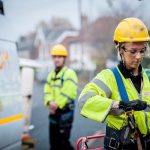Ofcom UK CEO Warns BT to “fibre-up, or risk fading away”
The boss of UK telecoms regulator Ofcom, Sharon White, has told a conference in London today that BT (Openreach) must replace their “Victorian-era” copper ISP network with a modern “full fibre” (FTTP/H) broadband alternative or “risk losing swathes of customers to [rivals].”
The strong words came as Openreach continues to be put under pressure for a perceived lack of investment in Gigabit capable Fibre-to-the-Premises (FTTP/H) networks. At present the operator expects to bring “ultrafast broadband” (100Mbps+) connections to 13 million premises by the end of 2020, although only 3 million of that will come from FTTP and the rest is be delivered via slower hybrid fibre G.fast solutions.
Achieving 3 million by the end of 2020 would actually be quite a significant level of progress but the challenge is around what comes next.
Advertisement
Clive Selley, CEO of Openreach, said:
“We’re now committed to delivering FTTP in 40 towns, cities and boroughs and in just a few short weeks we’ve raised the delivery rate of full fibre to over a thousand homes per week in Bristol and in Cardiff.
By the end of May, we’ll be building to 1000 homes each week in each of the eight cities we’ve announced in our first wave. We will double our FTTP footprint this year. And we don’t yet know how fast we can go.
But be assured Openreach will go full throttle, at scale, across 40 cities.
Openreach has previously indicated that they aspire to push FTTP out to cover 10 million premises by around 2025, although they have yet to set this in stone due to on-going concerns over the impact of regulation, disagreements with rivals and cost (£3bn to £6bn) etc.
The operator has previously warned (here) that reaching 10 million may only be possible with co-investment support from other ISPs (difficult since so many are now doing their own thing), as well as softer regulation, reduced logistical barriers (permissions / planning etc.) and the ability to switch-off old copper networks as areas go FTTP (very complex and rivals with an investment in copper services may obstruct).
Selley added:
“Builders like Openreach also need help from Government and Ofcom. I’m particularly encouraged by the approach of the DCMS barrier busting team, because everyone knows that network builders could go faster if there was less red-tape.
But it’s also important for the whole industry that we find a solution to business rates. One that promotes investment and better reflects the long term nature of what we’re all investing in.
Ofcom’s WLA review gives us more pricing certainty, but regulation must promote FTTP investment and take-up, so investors need unequivocal support for the switchover from copper to fibre, and greater flexibility to withdraw legacy products when launching new ones.
In the longer term, we believe the model needs fundamental change to guarantee customers quality and choice. We can achieve that by:
• Incentivising fibre investments that allow a fair return
• Encouraging competition outside urban clusters
• And recognising that a three year regulatory review cycle is too short.”
Nevertheless Ofcom’s CEO has also noted the tremendous progress being made by alternative network (AltNet) providers (B4RN, Hyperoptic, Gigaclear, TalkTalk, Vodafone, Cityfibre etc.), which between them have committed to deliver FTTP/H to millions of homes and businesses over the next few years (see our summary).
Sharon White, Ofcom CEO, said:
“If incumbents who rely on copper don’t change course, they risk losing swathes of customers to full-fibre rivals. Incumbents face a choice in my view – fibre-up, or risk fading away.
History is strewn with once-successful companies that failed to anticipate and act on shifts in customer demands and to innovate. Think Kodak, Polaroid, Palm and Blockbuster.
The UK cannot afford for BT to be added to that list.
…
Over the next few years, the number of homes and businesses able to benefit from full fibre is set to rise from one to six million. That is one fifth of homes and businesses – good progress.
But some way short of the ambition that full-fibre is available nationwide. So we must build on the early momentum.”
Sharon added that the regulator’s approach would “continue to be anchored” in the principle of the ‘fair bet’ (i.e. the certainty that risky investments will earn a fair return). She separately noted that Ofcom would also aim to extend the time between its big regulatory interventions (market reviews) from 3 to 5 years. Finally, she welcomed Openreach’s “fibre first” commitment but clearly wants them to go much further.
Advertisement
As usual the challenge is with the difficulty of marrying the industry’s many competing interests and turning those into some sort of agreement, which is always easier said than done. On the other hand there may also be something to be said for allowing AltNets time to grow their own networks first (natural competition), without fear of maximum pressure being applied in the same areas by Openreach or radical changes by the government.
AltNets don’t face the same regulatory baggage as Openreach, which is part of the reason why so many of them have been able to build and offer much cheaper / faster “full fibre” services than Openreach. This may also create an additional obstacle for Openreach’s co-investment idea.
Meanwhile the Government could yet throw another curve ball into the mix when they publish their Future Infrastructure Review sometime this summer, which is considering what changes may need to be made in order to boost investment in “full fibre.” One of those ideas could involve a return to the murky world of Regional Franchises (here).
Time will tell but nobody ever said that ‘Building a Full Fibre Future’ would be either easy, quick or cheap.
Advertisement
Mark is a professional technology writer, IT consultant and computer engineer from Dorset (England), he also founded ISPreview in 1999 and enjoys analysing the latest telecoms and broadband developments. Find me on X (Twitter), Mastodon, Facebook, BlueSky, Threads.net and Linkedin.
« O2 to Upgrade 1000 UK Sites with 2.3GHz Based 4G Mobile Spectrum
Green ISP Launch UK 330Mbps G.fast Home Broadband Service »

















































Comments are closed